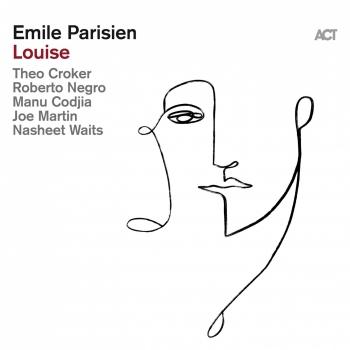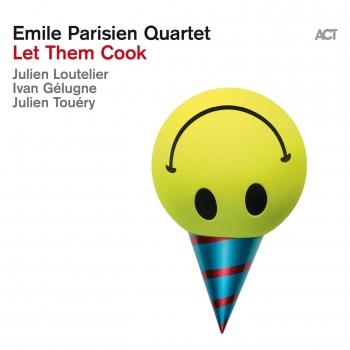
Louise Emile Parisien
Album info
Album-Release:
2022
HRA-Release:
28.01.2022
Album including Album cover Booklet (PDF)
- 1 Louise 05:47
- 2 Madagascar 08:21
- 3 Memento, Pt. I 07:15
- 4 Memento, Pt. II 02:56
- 5 Memento, Pt. III 05:15
- 6 Il Giorno Della Civetta 05:35
- 7 Jojo 05:23
- 8 Jungle Jig 03:36
- 9 Prayer 4 Peace 05:50
- 10 Madagascar (Single Edit) 04:41
Info for Louise
“The best new thing that has happened in European jazz for a long time” (Le Monde), Emile Parisien has formed a top-flight American-European sextet for this album, his seventh as leader or co-leader on ACT. The band will be touring in 2022, the year which also marks the tenth anniversary of Parisien’s first appearance on an ACT album.
The saxophonist developed his strong sense of direction in music remarkably early: he was 10 years old when the news reached his family in Cahors that a new music school would be opening up roughly 200 kilometres away in Marciac. The young-ster told his parents that this was the school he wanted to go to as a boarder...and so, with their support and approval, off he went. And it was through the school and the festival in Marciac that he received mentorship from some of the greats of North American jazz: Wynton Marsalis (who appeared as a guest on the album Sfumato Live), Clark Terry, Bobby Hutcherson, Oscar Peterson…
The fact that three of the musicians in the sextet on "Louise or half of the band is American (Theo Croker (trumpet), Joe Martin (bass), and Nasheet Waits (drums) is important for Parisien: “It was time for me to return to the source that gave me the love for this music in the first place,” he explains. The idea of a ‘return to the source’ is especially true of Parisien’s choice to work alongside Theo Croker, the grandson of trumpeter Doc Cheatham (1905-97). Parisien describes their meeting on the “Jazz Animals” tour in 2018 as having been a ‘super-rencontre’, and a particularly strong musical connection and a personal friendship have developed since those meetings. On “Louise” Parisien has not only ensured that a huge emotional and stylistic range can be heard in Croker’s trumpet-playing, but has also enjoyed matching and intertwining his own melodic voice with Croker’s. Their interaction is something special, and provides some of the many joyous moments on this wide-ranging yet very coherent album. Parisien has also generously given Croker the chance to have last word on the album, with his solemnly evocative composition, “Prayer for Peace”.
Drummer Nasheet Waits is a vivid and energising presence throughout the album, and especially in the third part of “Memento”, the most substantial piece on "Louise", which Parisien dedicates to his mother. “I just love Nasheet’s playing, he’s unbelievable. It was a dream to play with him,” says Parisien who first admired Waits’ playing on record, before their paths started to cross at festivals. This is the first time they have worked together. Joe Martin is one of the first-call New York bassists; Parisien knows him from their time as fellow members of Yaron Herman’s quartet.
Manu Codjia and Robert Negro are two of Emile Parisien’s very closest musical colleagues. “We have played in so many contexts, explored so much music together,” says Parisien. Guitarist Codjia was one of the very first musicians whom he met when he first moved to Paris nearly two decades ago. “Manu has an amazing ability to be the ‘glue’ that holds a band together and creates a common sound.” Codjia has contributed the composition "Jungle Jig", an energetic piece in which an ideal balance has been struck between chaos and order. Roberto Negro has also played with Parisien regularly as a duo, in Sfumato and other contexts. “European music, classical, jazz, Roberto plays them all so well! He’s such a complete musician,” says Parisien. Roberto Negro’s composition “Il giorno della civetta” (civet) is elegantly paced and has a wonderfully natural flow.
The title track “Louise” is gentle, spacious and meditative. The title refers to the ‘spider’ sculptures of Louise Bourgeois. These sculptures have mostly been seen in public spaces, and that has caused Parisien to reflect on how confinement during lockdown has deprived us all of the joy of being out in the open. Bourgeois’ sculptures are also very strongly connected to themes of motherhood, and to the metaphors of spinning, weaving, caring and protecting. Parisien’s affection for and valuing of the unconditional love of mothers for their children is the emotional background to this evocative track, with its glorious solos from Theo Croker and Manu Codjia.
Two pieces bring to the fore European musicians from earlier generations who have been decisive influences on Parisien: “Jojo” is a happy reference to Joachim Kühn; the track is unmistakably, intentionally, and deeply ‘Ornette-ish’ in its inspiration. “Madagascar” by Weather Report recalls a time when Parisien played in The Syndicate, the band formed in 2007 to carry on Joe Zawinul’s legacy and to perform his music.
“Louise” is a remarkable album in which ferocious energy contrasts and co-exists happily with a much softer side. Its subtleties and joys emerge the more one listens. As a result, "Louise" gives us the closest insight yet into the character and the creative individuality of one of Europe’s leading jazz musicians.
Emile Parisien, soprano saxophone
Theo Croker, trumpet
Roberto Negro, piano
Manu Codjia, guitar
Joe Martin, bass
Nasheet Waits, drums
Emile Parisien
The French jazz scene has a vitality, an originality and a do-it- all and do-it-anyway mentality about it right now. It is French musicians who are blazing the new trails for contemporary European jazz. There is a wonderful open-mindedness towards all musical cultures, genres and tendencies; and yet French musicians also give off the sense of having a proper grounding in their own tradition. A musician who represents all of these tendencies ‘par excellence’ is saxophonist Emile Parisien. Born in Cahors in the wine-growing region of the Lot, he is a jazz visionary. He may have one foot in that ancient soil, but his gaze is firmly fixed on the future. The leading French newspaper Le Monde has called him “the best new thing that has happened in European jazz for a long time,” while the Hamburg radio station NDR made the point of telling its listeners to give Parisien their “undivided attention.”
The reference points on Parisien’s personal musical map are very widely spread indeed. They range from the popular folk traditions of his homeland to the compositional rigour of contemporary classical music, and also to the abstraction of free jazz. And yet everything he does has a naturalness and authenticity about it. Rather than appearing pre-meditated or constrained, his music has a flow, he traverses genres with a remarkable fleetness of foot and an effortless inevitability.
What is it that makes the simple urgency of Parisien’s music quite so enjoyable? How does he manage to combine a provocative and anarchic streak with such a captivating sense of swing? Anyone who has seen and heard him on stage will know: it is because he lives his jazz with body and soul, because there is an authenticity and honesty inflecting every breath and every note.
Booklet for Louise












